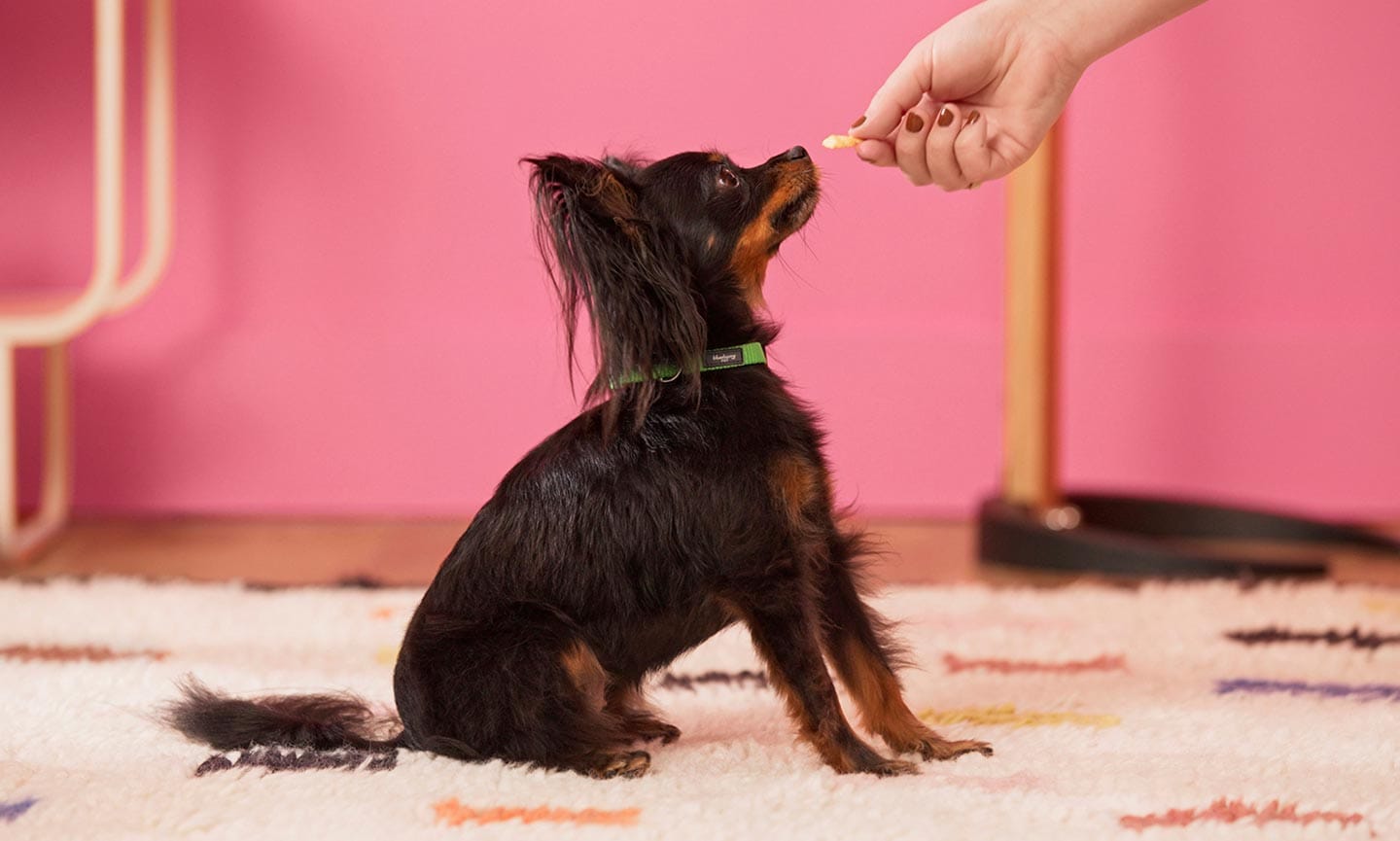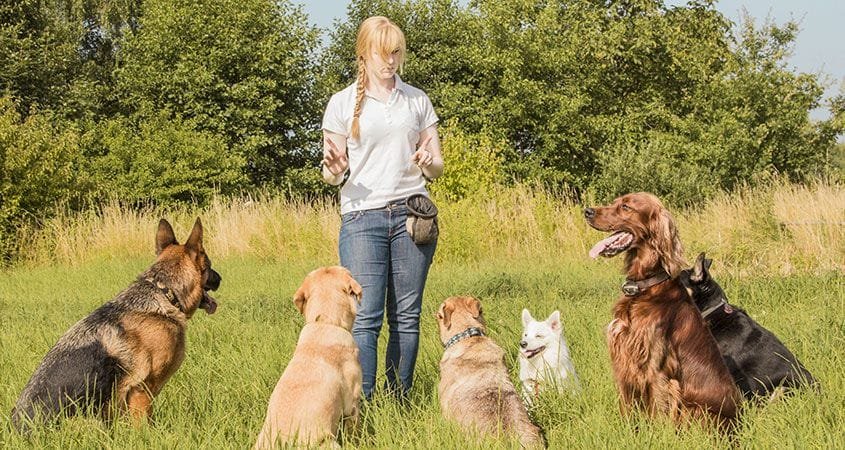To teach the basic obedience command “Sit,” hold a treat close to your dog’s nose and move your hand up, causing their bottom to lower. Once in a sitting position, say “Sit,” give them the treat, and show affection.
Hand commands for sit in dogs can be done by using an upward-facing palm.

Credit: be.chewy.com
The Importance Of Teaching The Sit Command
Building a Foundation of Obedience:
Teaching your dog the sit command is the first step in building a solid foundation of obedience. It establishes a clear line of communication between you and your furry companion. When your dog understands and follows the sit command, it sets the stage for further training and helps create a harmonious relationship between you and your pet.
Establishing Control and Discipline:
One of the essential aspects of dog training is establishing control and discipline. When your dog learns to sit on command, it learns to control impulsive behaviors and becomes more responsive to your instructions. The sit command not only teaches your dog to listen and obey but also promotes self-control and calmness in various situations. This command is particularly helpful when you encounter distractions or need your dog to wait patiently.
| Benefits of Teaching the Sit Command: |
|---|
|
With the proper training techniques and consistent practice, you can teach your dog the sit command effectively. Remember to use positive reinforcement, such as treats and praise, to reward your dog’s successful execution of the command. Soon, you’ll have a well-trained and obedient companion who understands and follows your instructions.
:strip_icc()/how_to_train_your_dog_to_sit_1117306_1599-47e4cccf366d48ddb22b2109efb87e53.jpg)
Credit: www.thesprucepets.com
The Steps To Teach The Sit Command
To teach the sit command, hold a treat close to your dog’s nose and move your hand up. This will cause their head to follow the treat and their bottom to lower. Once they are sitting, say “Sit,” give them the treat, and show affection.
Teaching your dog the sit command is an essential part of their obedience training. It helps to establish control and fosters good behavior. Here are the steps to teach your dog the sit command:
Using Treats And Hand Signals
Using treats and hand signals can be an effective way to teach your dog the sit command. Follow these steps:
- Hold a treat close to your dog’s nose.
- Move your hand up, allowing their head to follow the treat and causing their bottom to lower.
- Once they are in a sitting position, say “Sit,” give them the treat, and offer affection as a reward.
Using Leash Pressure
Another method to teach the sit command is by using leash pressure. Here’s how:
- Attach a leash to your dog’s collar.
- Gently apply upward pressure on the leash while giving the command “Sit.”
- Release the pressure once your dog sits, and reward them with praise and a treat.
Teaching Sit Without Physical Cue
It’s also possible to teach your dog to sit without using physical cues. Follow these steps:
| Steps | Description |
|---|---|
| 1 | Stand in front of your dog and say “Sit” with a clear and firm voice. |
| 2 | Wait for your dog to naturally sit down. |
| 3 | Once they sit, reward them with praise and a treat. |
Remember to be patient and consistent when teaching your dog the sit command. Practice regularly in different environments and gradually reduce the reliance on treats and hand signals. With time and practice, your dog will learn to sit on command reliably.
Common Mistakes To Avoid
When it comes to teaching your dog the basic obedience command – sit, there are a few common mistakes that owners often make. Avoiding these mistakes will help ensure that your training sessions are effective and your dog learns the command properly.
Inconsistency In Training
Inconsistency in training is one of the biggest mistakes dog owners can make when teaching their dogs the sit command. Consistency is key when it comes to dog training. If you use different hand signals or verbal cues each time you ask your dog to sit, it will only confuse them and make it more difficult for them to understand what you want.
TIP: Stick to the same hand signal and verbal cue each time you want your dog to sit. For example, use an upward-facing palm and say “sit” consistently. This will help your dog associate the command with the action more easily.
Not Using Positive Reinforcement
Another common mistake is not using positive reinforcement during the training process. Dogs respond best to reward-based training methods, where they are praised or given treats for performing desired behaviors. If you solely rely on punishment or scolding when your dog doesn’t sit, it can create a negative environment and make the training experience unpleasant for your furry friend.
TIP: Use positive reinforcement techniques such as giving treats, verbal praise, or affection every time your dog successfully sits on command. This will motivate them to repeat the behavior and associate sitting with positive experiences.
In conclusion, consistency in training and using positive reinforcement are crucial elements when teaching your dog the sit command. By avoiding these common mistakes, you can create a positive training environment and help your dog learn this basic obedience command effectively.
Additional Commands To Teach
Once your dog has mastered the basic sit command, it’s time to move on to teaching them additional commands. These commands are essential for a well-trained and obedient dog. By teaching your dog these commands, you can ensure they have better control and understanding of how to behave in various situations.
Down
The “down” command is often used to teach your dog to lie down on command. This command is especially useful in situations where you need your dog to stay still and not move around. To teach this command:
- Start with your dog in a sitting position.
- Take a treat and hold it close to their nose.
- Slowly move your hand down towards the ground, encouraging them to lower their body.
- Once they are in a lying down position, say “down” and give them the treat.
- Repeat this process several times until your dog understands the command.
Stay
The “stay” command is crucial for keeping your dog in one place. This command can be a lifesaver in situations where you need your dog to stop and stay put. To teach this command:
- Start with your dog in a sitting or lying down position.
- Hold your hand up in front of them, palm facing towards them.
- Step back slowly while giving the verbal command “stay”.
- If your dog stays in position, praise them and give them a reward.
- If they try to move, calmly guide them back into position and start again.
Come
The “come” command is one of the most important commands to teach your dog. It ensures that your dog comes to you when called, which is essential for their safety and control. To teach this command:
- Start in a safe, enclosed area without distractions.
- Get down on your dog’s level and open your arms wide.
- Use an enthusiastic tone and say “come” while patting your thighs.
- When your dog approaches you, reward them with praise and a treat.
- Practice this command regularly in various locations and gradually increase distractions.
Remember, consistency is the key to success when teaching your dog new commands. Keep training sessions short and positive, and always reward your dog for their good behavior. With patience and practice, your dog will become a well-behaved companion who understands and follows your commands.
Training Resources And Tips
To teach your dog the basic obedience command “Sit,” hold a treat close to their nose and move your hand up, causing their bottom to lower. Once they’re in a sitting position, say “Sit,” give them the treat, and show affection.
Use an upward-facing palm for the hand command.
Recommended Books On Dog Training
If you’re looking for comprehensive resources to help you with training your dog to sit, these books should be on your radar:- “The Art of Raising a Well-Behaved Dog” by Monks of New Skete: This acclaimed book provides step-by-step instructions on teaching basic obedience commands like sit, as well as more advanced training techniques.
- “Don’t Shoot the Dog: The New Art of Teaching and Training” by Karen Pryor: This book focuses on positive reinforcement techniques and how to effectively communicate with your dog, making it a valuable resource for teaching any command.
- “How to Behave So Your Dog Behaves” by Dr. Sophia Yin: Dr. Yin’s book is a must-read for dog owners looking to establish a strong foundation of obedience. It provides guidance on teaching sit, stay, and other essential commands.
Online Training Videos And Tutorials
If you prefer learning through visual demonstrations, these online training videos and tutorials can be incredibly helpful:- Nate Schoemer’s YouTube Channel: Nate Schoemer is a renowned dog trainer who offers a wide range of helpful videos on his YouTube channel. His videos cover various aspects of dog training, including teaching the sit command.
- Southeastern Guide Dogs YouTube Channel: This channel provides valuable resources for teaching basic obedience commands to your dog, including helpful videos on teaching sit.
- RSPCA’s Training Videos: The RSPCA offers an excellent collection of training videos on their website, covering various commands, including sit. These videos are easy to follow and provide practical tips for successful training.
:max_bytes(150000):strip_icc()/GettyImages-1132264214-2000-6114d7a3563447c5a7d88c95db78fec1.jpg)
Credit: www.southernliving.com
Frequently Asked Questions Of Basic Obedience Commands: Sit
What Is The Command Of Sit?
To command your dog to sit, hold a treat near their nose and move your hand up, causing their bottom to lower. Once they are in a sitting position, say “sit,” give them the treat, and show affection.
How Do You Teach Sit Commands?
Teaching sit commands can be done by holding a treat close to your dog’s nose, then moving your hand up to allow their head to follow the treat. This causes their bottom to lower into a sitting position. Once they are sitting, say “Sit” and give them the treat, along with praise and affection.
What Are The Hand Commands For Sit In Dogs?
To teach your dog the “sit” command, hold a treat close to their nose and move your hand upward. The dog’s head will follow the treat, causing their bottom to lower into a sitting position. Once they sit, say “Sit,” give them the treat, and show affection.
Use an upward-facing palm as the hand command for “sit. “
What Are Basic Dog Obedience Commands?
Basic dog obedience commands include “sit,” “stay,” “down,” “come,” and “heel. ” To teach your dog to sit, hold a treat near their nose and move your hand upwards, causing their bottom to lower. Say “sit,” give them the treat, and show affection.
Hand signals for sit include an upward-facing palm.
Conclusion
To teach your dog the basic obedience command of “Sit,” start by holding a treat close to their nose and moving your hand up. This will cause their bottom to lower as they follow the treat. Once they are in a sitting position, say “Sit,” give them the treat, and show them affection.
Remember to be patient and consistent in your training sessions. With practice, your dog will become proficient in this important command. Happy training!







